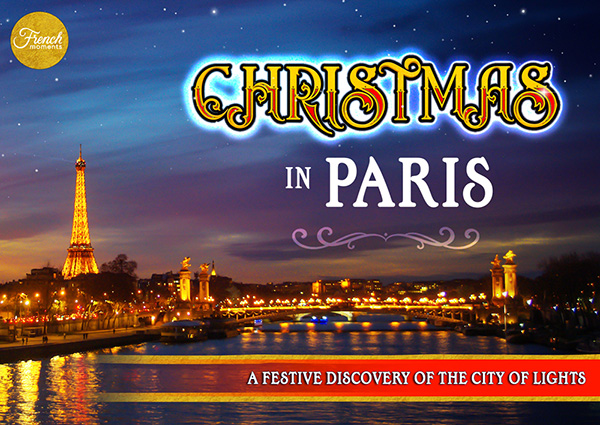The Christmas Pyramid, also known as the Advent Pyramid, is an important decorative element of the Christmas season in German countries. For several years now, it has been making its way into the French Christmas scene, albeit timidly. I did my research and it turned out to be a fascinating task. I never imagined that there was so much to say about this tradition! This is what I realised while going through dozens of pages in German (French and English resources are still very sporadic on the subject!) Let’s lift the mystery on the wonderful history of this symbol of light. A Christmas tradition that delights our eyes with its festive glow!
What is a Christmas pyramid?
This traditional German decorative object takes the form of a wooden carousel, like a multi-storey revolving crib.
- The heat from the candles drives the upper mill, turning the trays on each floor with its figures.
- The figurines illustrate either the Nativity (crib, angels, shepherds, the Holy Family, the Magi…) or secular themes (Father Christmas, snowman, forest animals…).
- The spinning propeller blades create an enchanting play of light and shadow.
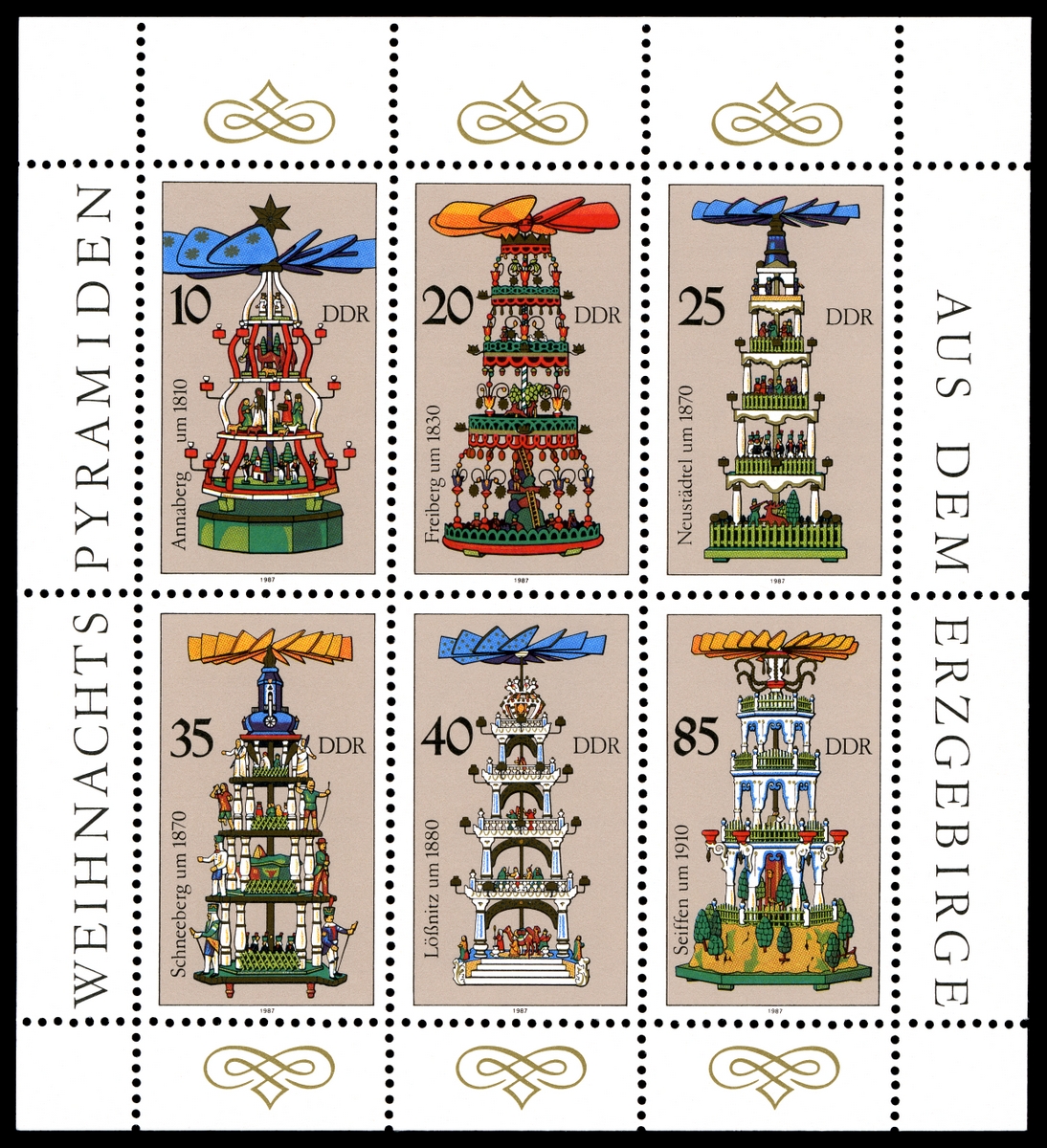
There are two types of Advent or Christmas pyramids:
- the miniature pyramid, which is a decorative element for the house
- the large open-air pyramid, whose structure decorates Christmas markets
Let’s start with the miniature!
The miniature pyramid and its origins
The origins of Christmas pyramids go back to the Middle Ages. Documents tell us that in the 16th century, pyramid-shaped structures were made in the Saxon and Brandenburg regions with four intertwined sticks tied together at the top, in the manner of a tepee.

These Lichtergestelle (literally scaffolding or light frames) were then decorated with boxwood, branches or paper, and candles.
During Advent, these structures (which did not rotate) were found in churches in Saxony and Brandenburg. They were sold at Christmas markets.
Pyramids of Berlin
The Lichtergestelle appeared in numerous pictorial representations from the late 18th century. The Berliners developed them by adding a tray on which they placed decorations. In the 19th century, they were the “trademark” of the Berlin Christmas market, even taking the name “Berlin Pyramid“.
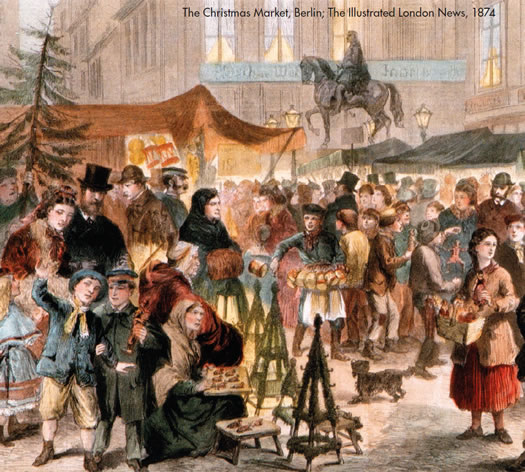
The precursor of the Christmas tree
The pyramid shape of the Lichtergestelle is reminiscent of the Christmas tree. It seems that they were the precursors. Indeed, the tradition of the Christmas tree was born in the 16th century in Alsace. The first written mention of a decorated Christmas tree is recorded in the archives of Sélestat (1521).

In the early days, the Christmas tree was popular with German Protestant families because it had the advantage of being a substitute for the Catholic Christmas crib.
A decline due to the widespread use of the Christmas tree in Germany
In the 18th and 19th centuries, the Berlin Pyramid was one of the Christmas decorations used by Berlin families, both rich and poor. The decline, that led to its disappearance, was due to the spread of the Christmas tree tradition in large German cities during the 19th century.
Three major facts contributed to this small cultural upheaval:
- The German campaign of 1813. The German states subjected by Napoleon rose against him one after the other. This uprising culminated in the Battle of Leipzig (16-19 October), which marked the withdrawal of the French army to France. It seems that the tradition of the Christmas tree, which had been confined to the Upper Rhineland (including Alsace), spread to the north and north-east of Germany at this time. This symbol of light had become the symbol of German nationalism. It became a fixture in the living rooms of wealthy German families, regardless of whether they belonged to the Catholic or Protestant faith.
- But above all, the advent of the railway in Germany made it easier and cheaper to move large fir trees around. At that time, fir trees were scarce in Central Europe. At first, only the wealthier classes could afford to buy a Christmas tree for their living rooms. It was not until the second half of the 19th century that conifers were planted in the vicinity of large German cities to satisfy the demand for fir trees among city dwellers.
- Finally, the development of the revolving Christmas Pyramids, which originated in the Ore Mountains, contributed to the abandonment of the static Berlin Pyramids.
The Berlin Pyramid: the end of a tradition
However, the Berlin Pyramid still found favour with the poorest people in Berlin. Those who could not afford to buy a Christmas tree.
Towards the end of the 19th century, the Berlin pyramids disappeared for good from the German Christmas markets. The surviving examples are on display in Berlin’s museums.
The evolution towards the Christmas pyramid of the Ore Mountains
To understand the transformation of the Berlin pyramids into Christmas pyramids, one has to travel to the German region of the Ore Mountains (German: Erzgebirge), on the border with Bohemia (now in the Czech Republic).
In the 18th century, it seems that the shape of the Lichtergestelle inspired the miners of the region to think about its evolution.
The workers had every reason to appreciate the light pyramid. In their eyes, the Lichtergestelle reminded them of light.
A very strong symbol for those who risked their lives working in dark mines.
![Gallery of an iron mine near Annaberg (Ore Mountains) © Ad Meskens - licence [CC BY-SA 3.0] from Wikimedia Commons](https://frenchmoments.eu/wp-content/uploads/2021/11/Annaberg-Mine-de-Fer-©-Ad-Meskens-licence-CC-BY-SA-3.0-from-Wikimedia-Commons.jpg)
Since the 15th century, mining in the Ore Mountains has used the power of animals to draw water from manholes, for example. This inspired the idea of creating revolving platforms in the Lichtergestelle.
The heat generated by the candles set in motion a propeller at the top of the pyramid. The trays located at several levels of the structure began to rotate.
The Lichtergestelle had come alive. The Christmas pyramid was born!
![Advent Pyramid © Tamorlan - licence [CC BY-SA 2.5] from Wikimedia Commons](https://frenchmoments.eu/wp-content/uploads/2021/11/Weihnachtsmarkt-Pyramide-de-Noël-©-Tamorlan-licence-CC-BY-SA-2.5-from-Wikimedia-Commons.jpg)
Why the word ‘pyramid’?
The first mention of the word Pyramid attributed to the revolving Lichtergestelle in the Ore Mountains dates from 1716 (Schneeberg town archives). Thus, in that year, the word “Peremett” was used for the first time in the local dialect for our present-day Christmas pyramids.

However, this designation became widespread much later. As a result of the Egyptian campaign led by Napoleon Bonaparte and his successors from 1798 to 1801, images of the famous Egyptian pyramids reached Saxony.
From then on, the German people called the famous Lichtergestelle from the Ore Mountains, “Weihnachtspyramide” (literally, the Christmas pyramid).
When did the Christmas pyramids become widespread throughout Germany?
Until 1830, expensive materials such as tallow or vegetable oils were used to make candles. With the invention of paraffin, candles became more affordable for everyone. Thus, the tradition of Christmas pyramids quickly spread throughout the country.
![Detail of a Christmas pyramid (from Globenstein) © Klaaschwotzer - licence [CC0] from Wikimedia Commons](https://frenchmoments.eu/wp-content/uploads/2021/11/Globensteiner-Weihnachtspyramide-Detail-©-Klaaschwotzer-licence-CC0-from-Wikimedia-Commons.jpg)
The famous Globenstein pyramids
Until the beginning of the 20th century, the Christmas pyramids of the Ore Mountains were made individually, or in limited editions by talented craftsmen.
From the 1900s onwards, the Flemming company in Globenstein made a name for itself throughout Germany with its production of multi-storey pyramids using industrial processes.
![Promotion of the Globenstein Christmas pyramid on a local newspaper © Klaaschwotzer - licence [CC0] from Wikimedia Commons](https://frenchmoments.eu/wp-content/uploads/2021/11/Globensteiner-Weihnachtspyramide-©-Klaaschwotzer-licence-CC0-from-Wikimedia-Commons.jpg)
The producer delivered pyramid kits by post in cardboard packaging.
![Globenstein Pyramid 1935 © Klaaschwotzer - licence [CC0] from Wikimedia Commons](https://frenchmoments.eu/wp-content/uploads/2021/11/Pyramide-de-Globenstein-1935-©-Klaaschwotzer-licence-CC0-from-Wikimedia-Commons.jpg)
Consumers could choose from several heights of pyramids: from 80 cm to over 2 metres! The company promoted its pyramids so well in the newspapers that they became known as the “Globenstein Pyramids“. Flemming sold more than 5,000 copies a year. Production ended in 1948.
Indoor pyramids today
Today, miniature Christmas pyramids traditionally decorate the living rooms of German homes, along with the Christmas tree.
Some handmade models are 60 centimetres or even a metre long.

Pyramids are operated with candles or tea lights. Industrial models also offer electric pyramids.
Where to buy Christmas pyramids for your home?
If you stay in Germany or in Alsace, you will find them :
- on the stalls of the Christmas markets
- in Alsace, at the Christmas stores in Riquewihr (Féerie de Noël) or Strasbourg (Un Noël en Alsace)
- and if you can’t go there, on Amazon (click on this affiliate link to display the “Christmas Pyramid” category)
The Christmas pyramid at the Christmas market
Let us now head for the town of Annaberg, in the Ore Mountains region.
![Annaberg © ObčanČR - licence [CC BY-SA 3.0] from Wikimedia Commons](https://frenchmoments.eu/wp-content/uploads/2021/11/Annaberg-Buchholz-from-above-©-ObčanČR-licence-CC-BY-SA-3.0-from-Wikimedia-Commons.jpg)
Until the 1930s, the pyramid served only as an interior decoration.
In 1926, the porion Pollmer (a porion is a supervisor of several miners) living in Frohnau (a district of the town of Annaberg, Ore Mountains) had a generous idea.
Why not build a huge Christmas pyramid outside?
“A pyramid for everyone” that would be in plain sight. Pollmer died in 1929 and never saw his dream come true.
The construction of a large open-air pyramid in Frohnau did not begin until 1931. The very first outdoor Christmas pyramid was ceremoniously opened on 17 December 1933 in Frohnau. It was 4.75 metres high and had four floors with Gothic arches.
- The first floor housed camels,
- the second one displays the Holy Family and the Magi,
- the third of shepherds and their sheep and
- the last of the characters… of the mining industry.
- the top contained the angels singing a hymn.
Importantly, it was illuminated by electricity. In itself, it echoed the large Christmas tree on the Annaberg market square, which was first lit by electricity in 1926.
![At the Annaberg Christmas Market © SchiDD - licence [CC BY-SA 4.0] from Wikimedia Commons](https://frenchmoments.eu/wp-content/uploads/2021/11/Annaberg-Christmas-Market-2-©-SchiDD-licence-CC-BY-SA-4.0-from-Wikimedia-Commons.jpg)
The Frohnau pyramid was part of the local landscape for two years.
It was dismantled in 1935 due to political disputes. The Nativity was not to the taste of the Nazi regime in the district. All those who participated in its construction took pieces of the pyramid home with them.
The post-war period: the revival of the great Christmas pyramids
It was not until after the Second World War that the great Christmas pyramids reappeared in the landscape of the Ore Mountains.
Until the 1950s, there were exactly 10 of them, all located in the region.
Then about 16 in the 1960s and almost 60 in the 1970s.
The large Christmas pyramid at the Annaberg Christmas Market dates from 1992 and stands 10.5 metres high.
![The Christmas pyramid at the Annaberg Christmas market © SchiDD - licence [CC BY-SA 4.0] from Wikimedia Commons](https://frenchmoments.eu/wp-content/uploads/2021/11/Annaberg-Christmas-Market-1-©-SchiDD-licence-CC-BY-SA-4.0-from-Wikimedia-Commons.jpg)
A high concentration of pyramids… in Germany!
In the early 1990s, the large Christmas pyramids spread to Christmas markets throughout Germany:
- Hanover (1994), with a new 18-metre high pyramid in 2014.
- Dresden (1997), one of the largest in the world.
- But also Berlin, Bochum, Bonn, Braunschweig, Chemnitz, Darmstadt, Dortmund, Dresden, Dusseldorf, Erfurt, Hanover, Heidelberg, Kiel, Lübeck, Mainz, Osnabrück, Schweinfurt…
![Advent pyramid at the Annaberg-Buchholz Christmas market © 1971markus - licence [CC BY-SA 4.0] from Wikimedia Commons](https://frenchmoments.eu/wp-content/uploads/2021/11/Ortspyramide-Annaberg-Buchholz-02-©-1971markus-licence-CC-BY-SA-4.0-from-Wikimedia-Commons.jpg)
![The Christmas Pyramid at the Berlin Christmas Market © NoRud - licence [CC BY-SA 4.0] from Wikimedia Commons](https://frenchmoments.eu/wp-content/uploads/2021/11/Berlin-Weihnachtsmarkt-am-Roten-Rathaus-©-NoRud-licence-CC-BY-SA-4.0-from-Wikimedia-Commons.jpg)
![Pyramide de Noël au Striezelmarkt de Dresde © LH DD:Dittrich - licence [CC BY-SA 3.0] from Wikimedia Commons](https://frenchmoments.eu/wp-content/uploads/2021/11/Striezelmarkt-Dresden-©-LH-DDDittrich-licence-CC-BY-SA-3.0-from-Wikimedia-Commons.jpg)
![Christmas pyramid at the Magdeburg Christmas market - licence [CC BY-SA 2.0] from Wikimedia Commons](https://frenchmoments.eu/wp-content/uploads/2021/11/Weihnachtsmarkt-Magdeburg-licence-CC-BY-SA-2.0-from-Wikimedia-Commons.jpg)
![Heidelberg Christmas Market © Daderot - licence [CC0] from Wikimedia Commons](https://frenchmoments.eu/wp-content/uploads/2021/11/Heidelberg-Christmas-Market-©-Daderot-licence-CC0-from-Wikimedia-Commons.jpg)
Today, it is estimated that there are over 150 open-air pyramids in the Ore Mountains alone. Many of these pyramids remain standing throughout the year.
![Christmas pyramids in Johanngeorgenstadt © Kora27 - licence [CC BY-SA 4.0] from Wikimedia Commons](https://frenchmoments.eu/wp-content/uploads/2021/11/Johanngeorgenstadt-Christmas-Pyramids-©-Kora27-licence-CC-BY-SA-4.0-from-Wikimedia-Commons.jpg)
In France, it was not until the mid-2010s that these large Christmas pyramids appeared.
In 2014, Johanngeorgenstadt (Saxony) held the world record for the highest Christmas pyramid. This permanent structure still stands today at 25.52 metres high.
![The world's highest Christmas pyramid in Johanngeorgenstadt © Kora27 - licence [CC BY-SA 4.0] from Wikimedia Commons](https://frenchmoments.eu/wp-content/uploads/2021/11/Johanngeorgenstadt-Christmas-Pyramid-02-©-Kora27-licence-CC-BY-SA-4.0-from-Wikimedia-Commons.jpg)
Various purposes of the Christmas pyramids in Christmas markets
Although the Christmas pyramids have retained their original purpose in the Ore Mountains, they have adapted to the festive environment of the Christmas markets.
It is mainly the lower levels that have been modified. Here and there you will find an Advent pyramid with a Christmas decorations shop on the ground floor, a pyramid bar or a pyramid restaurant.
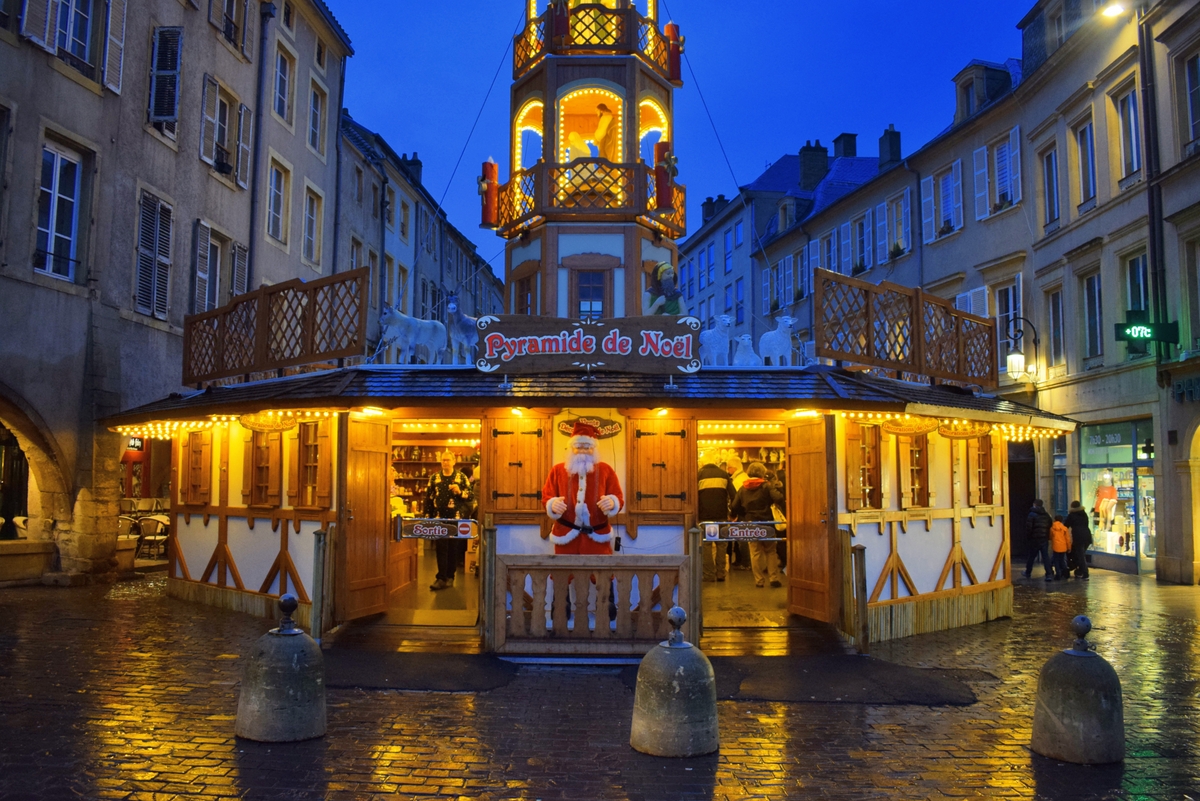
Many of these large outdoor pyramids (in Germany or elsewhere) come from the Ore Mountains… a nice tribute to their region of origin!
Christmas pyramids in France
In recent years, more Advent pyramids appeared at Christmas markets in France and Belgium.
The Metz Christmas Pyramid
Since its introduction in 2015, the Metz Pyramid has become one of the must-see attractions of the Christmas market, just like the Ferris wheel on Place d’Armes, the Lanterns Trail, or the open-air ice rink on Place de la République. Sleek and elegant, it stood until 2019 at the entrance to the Christmas village on Place Saint-Louis. From 2021, it was moved to Place de la République.
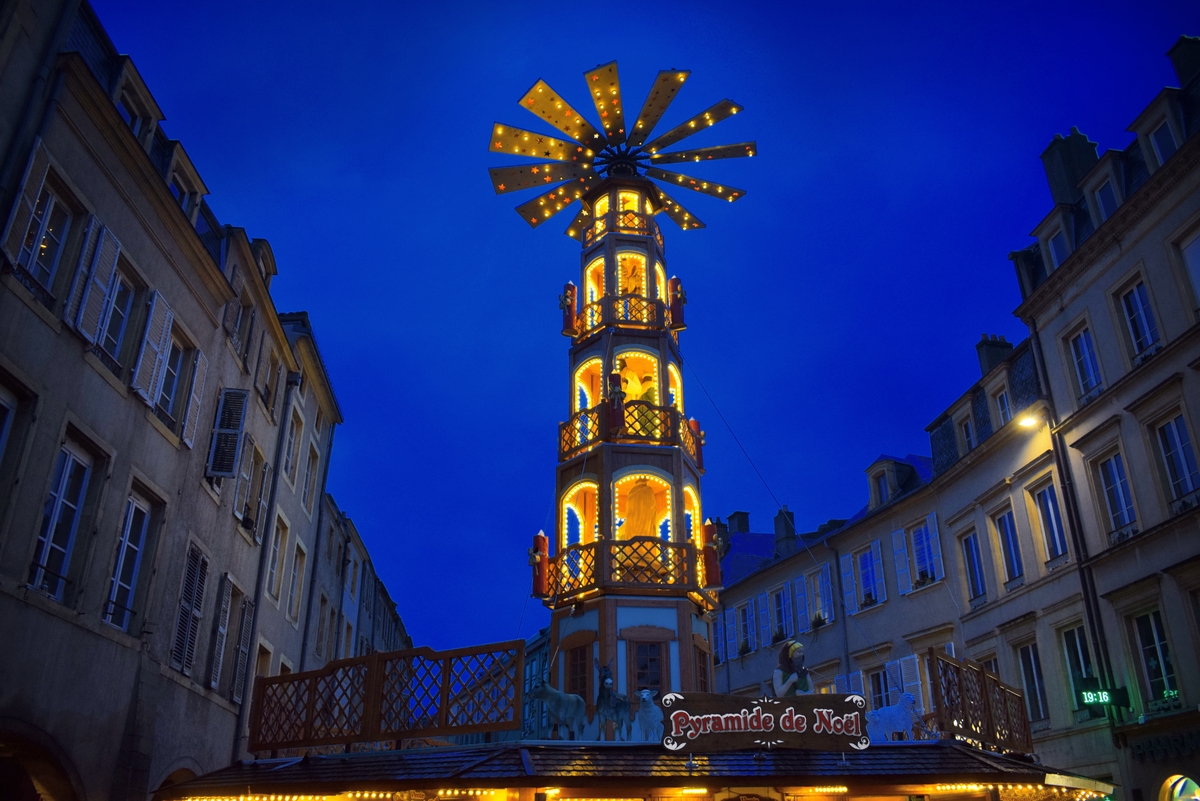
At 17 metres high and five storeys high, it is one of the highest in Europe.
- Its ground floor is occupied by a Christmas decorations shop.
- On the roof of the shop are the shepherds and their sheep.
- Joseph and Mary can be seen on the second floor.
- The third floor houses the Three Wise Men.
- The fourth floor houses the Angel Gabriel.
- Finally, the top floor seems strangely unoccupied…
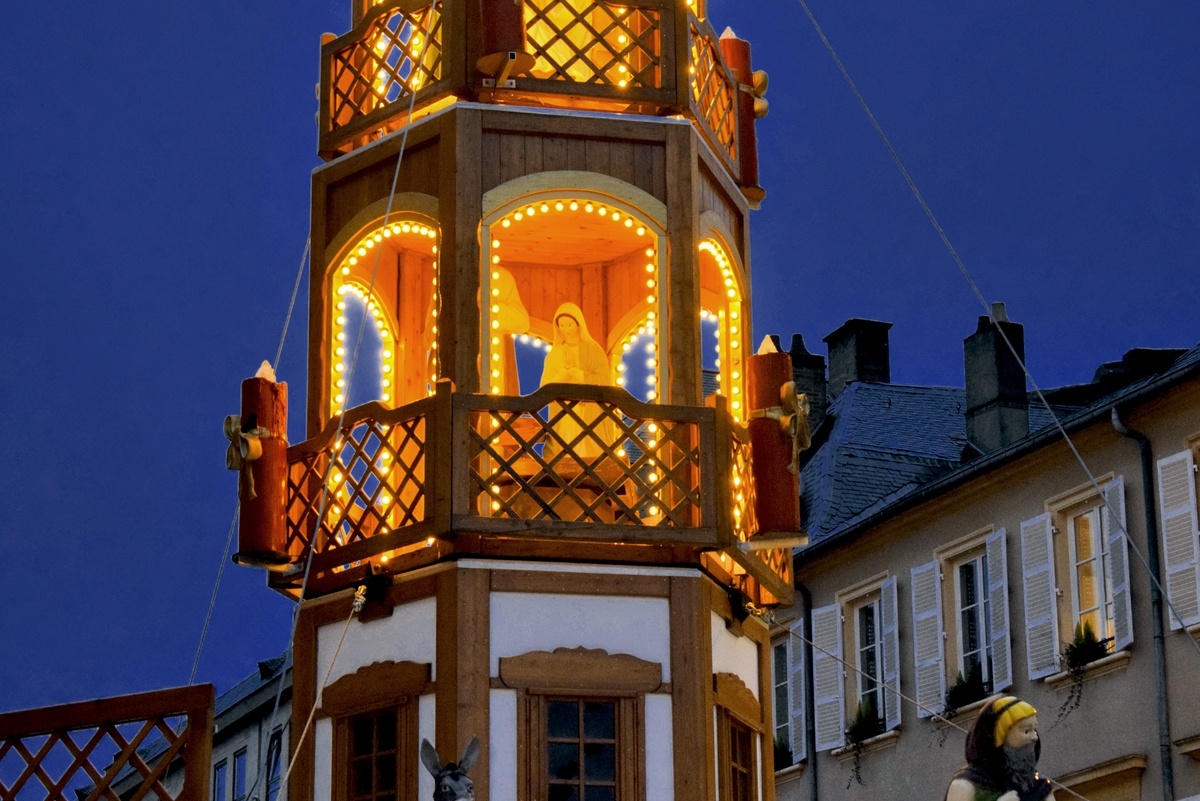
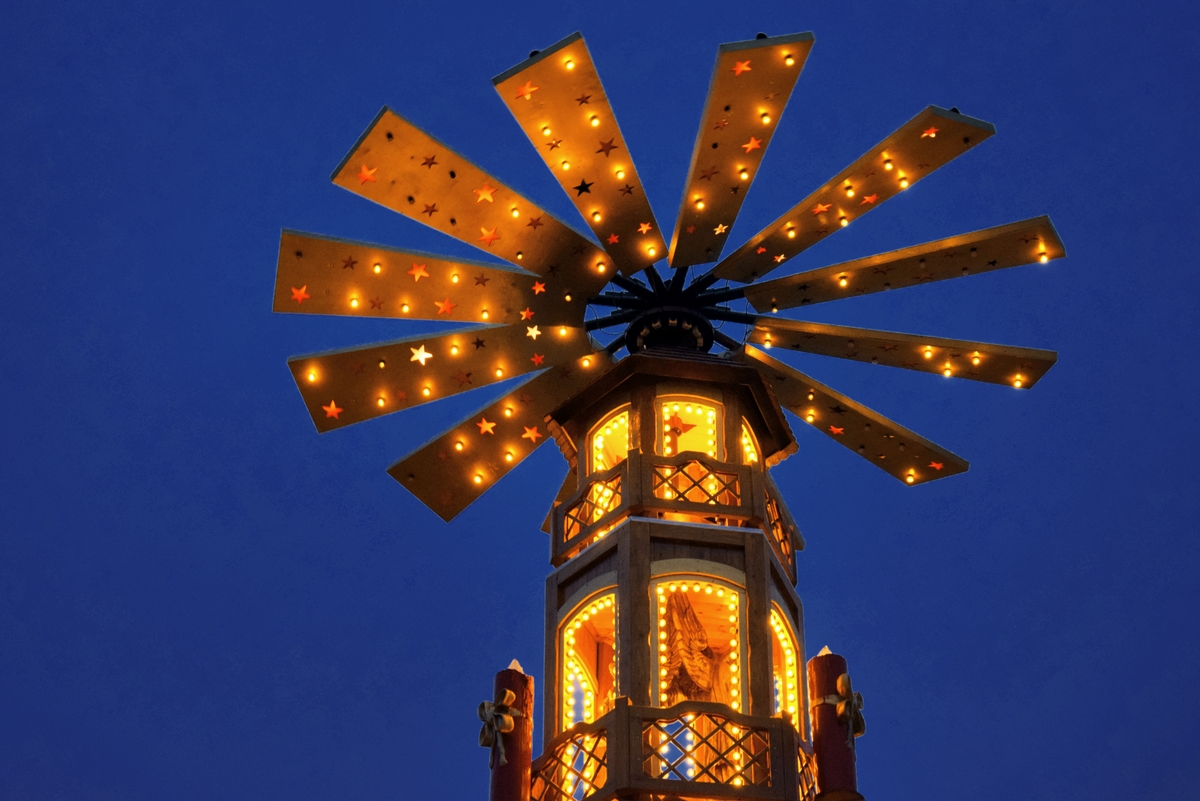
The pyramid seems to nod to the city’s German past when Germany annexed Metz between 1871 and 1918.
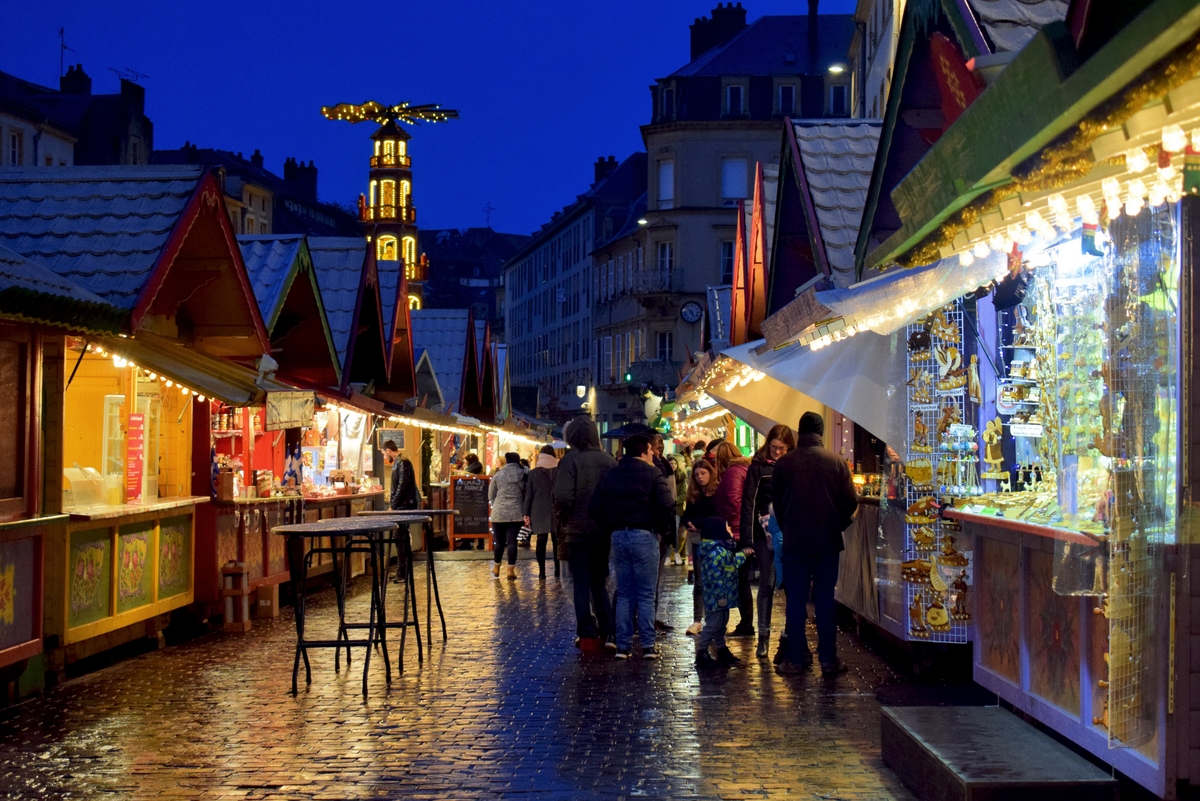
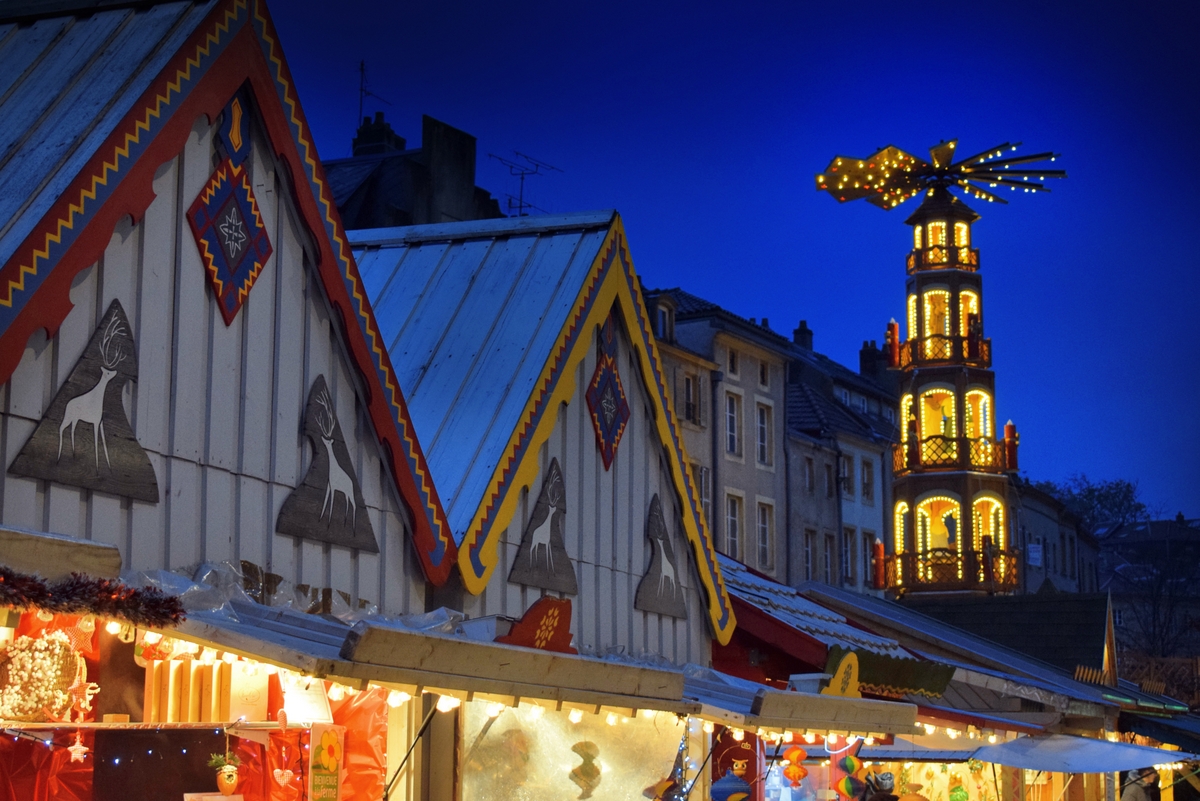
The Christmas Pyramid in Arras
It has stood on the Grand-Place in Arras since 2015.
The Christmas Pyramid in Calais
The Calais Christmas market also has a small pyramid.
The Christmas Pyramid in Nice
It resembles those of Metz and Arras, as it is of the same construction.
The Christmas pyramid in Strasbourg
It is so small that it is almost unnoticeable! Strasbourg’s Christmas pyramid decorates the Christkindelsmärik, and its floors are hopelessly empty of figurines and decorations.

The Angel Chime
The Christmas pyramid has inspired other Christmas decorations. The most famous is the angel chime (carillon d’ange in French).
The difference between a Christmas pyramid and an angel chime
The angel chime works on the same principle as the Christmas pyramid but is much smaller.
The heat from the four small candles at the base turns the propeller at the top of the mast. In this way, it drives a series of trumpet-playing cherubs that strike the bells.
- The pyramid is made of wood, the carillon is made of metal.
- The pyramid does not usually contain bells or trumpeting cherubs.
The origins of the angel chime
This Christmas decoration can be found in the German town of Solingen in Westphalia.
![An aspect of Solingen in Westphalia © CEphoto, Uwe Aranas - licence [CC BY-SA 3.0] from Wikimedia Commons](https://frenchmoments.eu/wp-content/uploads/2021/11/Solingen-©-CEphoto-Uwe-Aranas-licence-CC-BY-SA-3.0-from-Wikimedia-Commons.jpg)
In 1905, Walter Stock of the German company Adrian & Stock filed the first patent for an angel chime (Engelgeläute, Klingelpyramide or Lichter Glockenspiel).
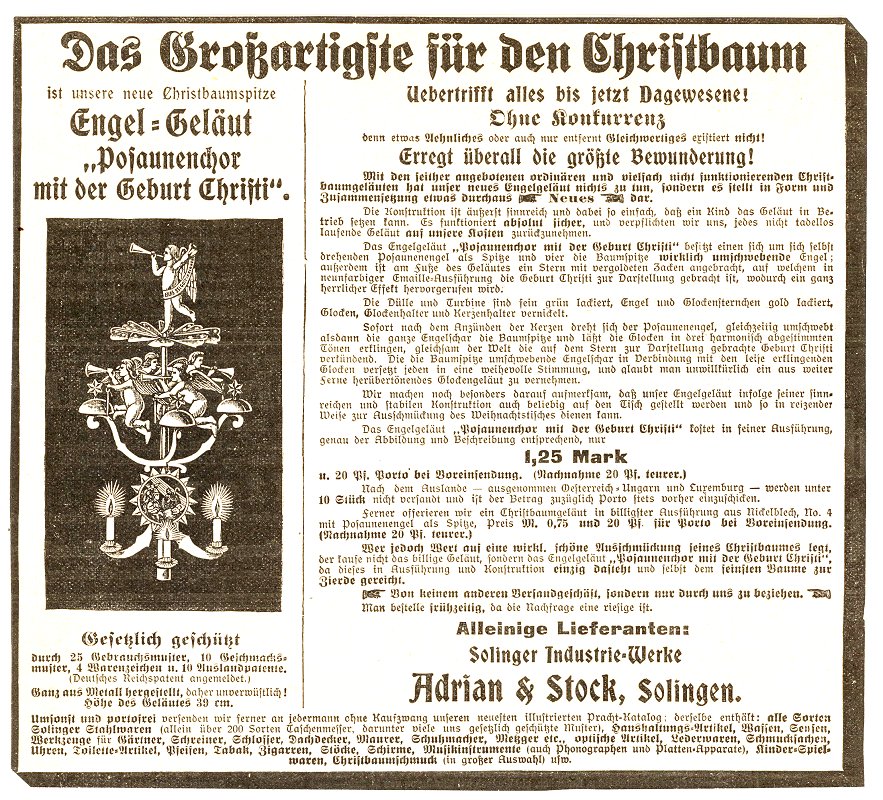
Although he was not the inventor, Stock described in detail the various elements of the chime. Mass production began in 1910 and Adrian & Stock further developed their chimes with different versions.
The company was taken over in 1933 by Paul Hartkopf, who continued to manufacture several models until the end of the 1960s.
When Paul Hartkopf’s company was dissolved, a large stock of unsold chimes was later found on the market.
Today, some of them are for sale on eBay, in new condition and in their original packaging.
A success equalled and copied!
The Adrian & Stock angel chime proved extremely popular. And it was widely copied.
Before the Second World War, Germany was the main producer of carillons. The war destroyed this monopoly.
Other manufacturers, especially Swedish ones, took over and imposed their aesthetic.
The Swedish structure was more streamlined than the pre-war German one. It was no longer lithographed or engraved like the “old style”.

In the post-war years, the American retail group Sears pursued an aggressive marketing policy to impose its “Swedish angel chimes” in the United States. So much so that most Americans believe that the angel chime originated in Sweden…
Buy your angel chime on Amazon (affiliate link)
Find out more about the origins of angel chimes
The Christmas candle bridge
Christmas candle bridges (German: Schwibbogen, French: arc lumineux) are Christmas decorations that originated with the miners of the Ore Mountains in Germany.
It is a classic Advent item, the earliest examples of which (dating from 1740) consisted of an iron arch with eleven candles on it. They were painted and displayed the sun, moon, and stars. One can imagine that the miners wished to represent the arc of heaven… at the bottom of the mine, they must have sighed for a sky that they did not see during the whole winter season!
Since then, lighted arches offer a great diversity according to the number of lights, the size of the bridge and its composition (wood or metal…), the scenes represented (crib, forest…). Some use candles, others are electric.
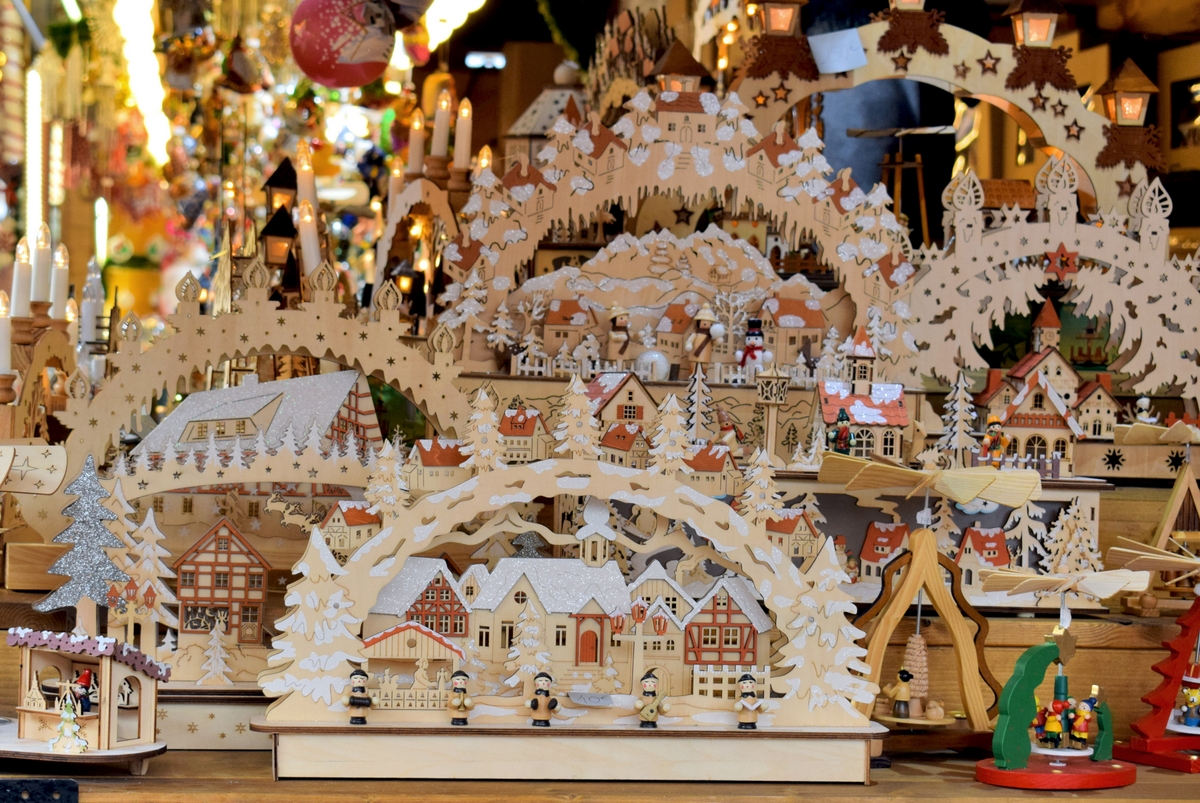


In France, they are known under several names: arc lumineux, arc décoratif, chandelier de Noël…
They are frequently used in interior decoration in Alsace, Germany and England.
Buy your Christmas candle bridge on Amazon (affiliate link)
Find out more about the Christmas Pyramid
- Read this article in French on our blog Mon Grand-Est
- The Most Beautiful Christmas markets in Germany
- The tradition of the Christmas markets in France
- The Christmas tree tradition and its origins in Alsace
- The French Christmas Traditions explained!
- The Christmas Pyramid on Wikipedia
Pin it for later!
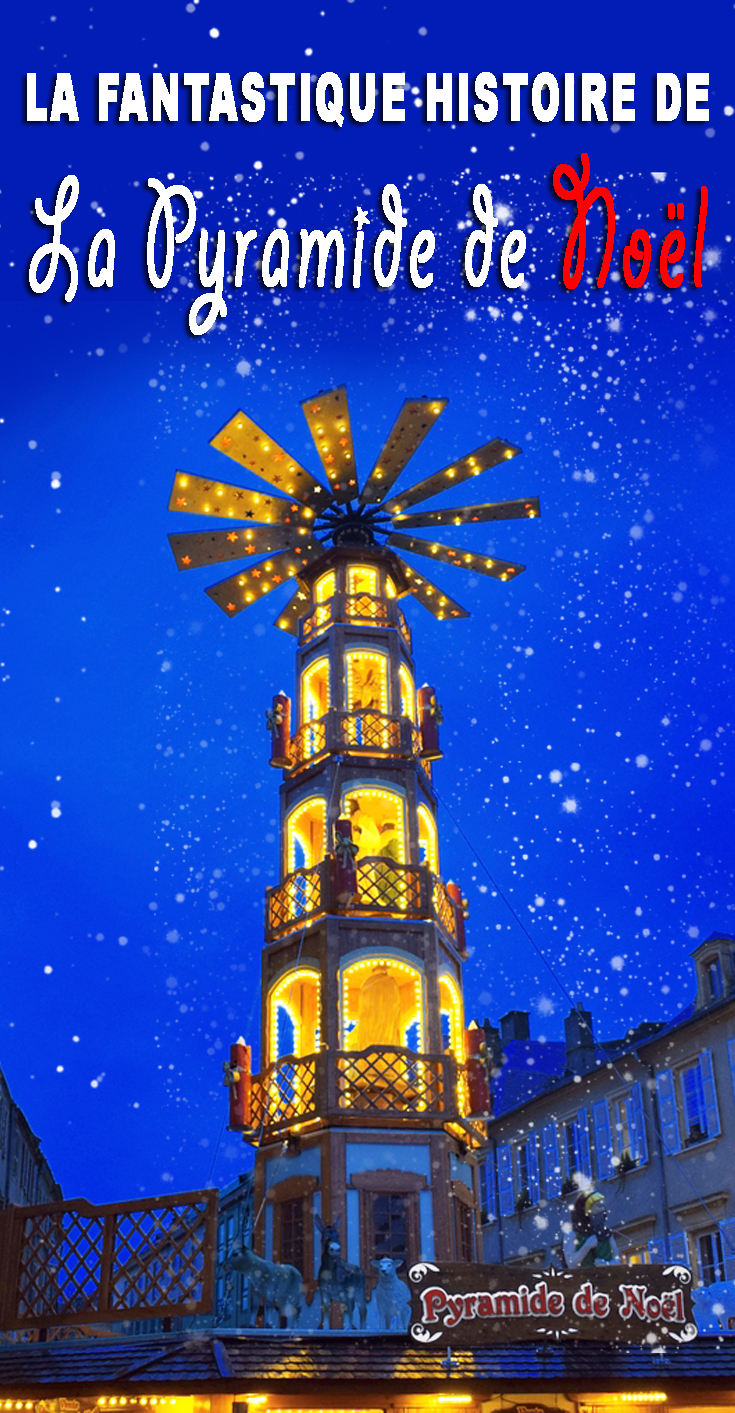
Affiliate links in this article allow me to earn commission on sales. They are at no extra cost to my readers and help me maintain this blog!


